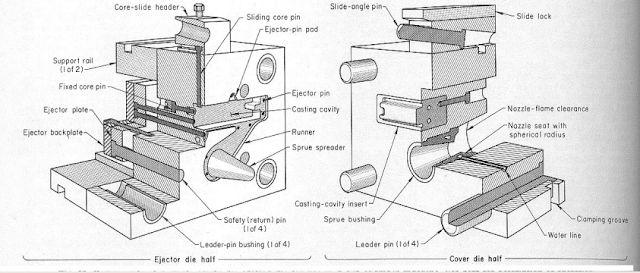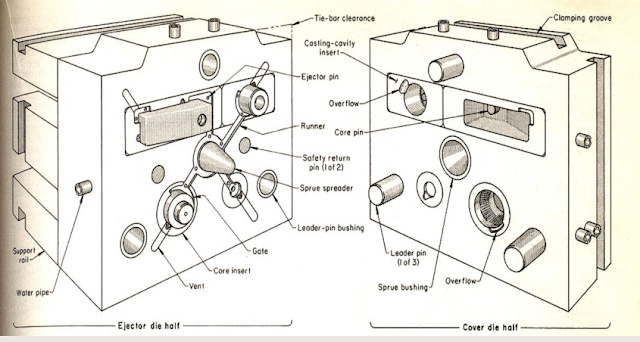Chapter 2 - Die Design Concept of die casting dies.
DIE CASTINGS dies consist of two sections – cavity or fixed die half and an ejector die or moving half, that meet at the die parting line. The cavity or fixed die half is secured tithe front or stationary platen of the casting machine. The spree for filling the die cavity is in this half and is aligned with the injector nozzle of a hot chamber die casting machine or with the shot chamber machine. The ejector die half contains the ejector mechanism and in most cases the runner. It is normally fastened to the movable die platen, which is coupled with the actuating or clamping mechanism of the die casting machine. A cross section of a simple hot chamber die casting die is illustrated in the next fig.
 |
Die_Design_Concept_of_die_casting_dies |
The die cavity is machined into the two halves
of the die block. The location of the parting line must ensure that, on opening
of the die, the casting will pull away from fixed die half and remain in ejector
half. Thus, when shapes having interior surface to be cast, as much of the
cavity are possible is located in the fixed die half, so that when the die is
opened, the casting will have shrunk onto the protruding ejector half, from
which it can be ejected.
Cores
Cores are die parts that produce holes, openings and other casting details. Cores that extend parallel with die movement and that therefore do not have to be removed before ejection of the casting is called fixed cores. The ejector pins force the casting from fixed cores as the casting is pushed out of the die cavity. Cores with axes not parallel with the die movement are called movable or sliding cores; these cores must be withdrawn by a separate mechanism before the casting is ejected from the die.
Slides
Slides are the movable die parts needed to build up die surfaces. Slides are used are used when it is impossible to avoid undercuts in a casting. The part of the die cavity wall that forms the undercut portion is made on the face of a slide, which is accurately fitted in a guide cut in the die block. The slide must be free retracted before the casting can be ejected. A separate locking mechanism must be provided for each slide. The use of slides adds considerably to die cost.
Runners and Gates
The metal entering the sprees directed into one or more passages or runners. Near the dies cavity, the cross-sectional area of the runner decreases to form a gate designed to direct the metal into the designed cavity.
Vents
Vents serve as outlets through which air can escape from the die cavity, permitting complete filling by the metal. Adequate venting may be provided by clearance between the defaces at appropriate location or venting may consist of the clearance between the die and movable cores, ejector pins and slides.
Overflows
For some castings, the die cavity may feed
into an overflow. Overflows perform several important functions as follows:
- They serve as receptacles for the first metal entering the die cavity during each shot. Normally this metal will be cooler than the metal behind it. In addition, it will oxidize to some extent as it forces the air that is in the cavity out through the vents. Feeding this cooler, oxidized metal to overflows both avoids cold shuts and traps any included any oxides in appendages to the casting, which are latter trimmed off, remitted and recovered.
- They provide additional mass to small castings, thereby helping to maintain a satisfactory and stable die temperature.
- They serve as locations for Contacto ejector pins when the casting themselves are not permitted to have ejector pin marks on any surface.
Cooling
In die casting, there is hot metal in the cavity during a large portion in each cycle and cycle frequency is rapid; heat is dissipated to and retained by dies, especially around the sprue and around heavy cross sections in the casting. To prevent overheating of a die, sections of the die are cooled to a controlled temperature by water circulating through passages drilled in these sections. Temperature control is achieved by control of the amount of the water in circulation. Locations of water-cooling lines in production die sets to be designed suitably.
TYPES OF DIES
Parts maybe die cast one at a time in single cavity dies or in sets in multiple cavities dies. Dies that have cavities for producing different parts in the same die are called combination dies. When small parts suitable for casting in combination dies are to be made, but unequal quantities of the various parts are required, a combination die can still be used economically if it consists of a single die block containing machined-out recessions of equal size, for insertion of interchangeable dies.
(1). Single Cavity Die
Single cavity dies are used when: a) Casting to be produced has so large a surface area that the die for one casting fills the die space in the machine. b) The volume of metal required for the casting is near the hot capacity of the machine. c) The production quantity does not warrant larger machine for multiple casting productions. d) A suitable machine for multiple cavity production is not available e) The complexity of the casting requires movable slides and cores that preclude the use of more than one cavity
 |
| Single_Cavity_Die |
The liquid metal is injected through the sprue opening and is deflected by the sprue spreader to begin its flow into the runner and then into the cavity. A fixed core pin forms an accurate hole in the die casting. A simple slide core pin is used for forming a hole in the sidewallof the casting just above the boss that is cored by the fixed core. The side core is attached to the to the core-slide header, which moved by an angle pin affixed to the cover die half. As the die opens, the angle pins move the header out from the die block, thus pulling the core pin out of the casting, which can be ejected at the end of the machine operated stroke.
(2). Multiple Cavity Die
Multiple cavities die consist of two or more duplicate cavities for making identical castings in one die. A multiple cavity dies, compared to a single cavity die reduces the unit cost per casting of producing a greater number of castings per machine-hour. In addition, multiple cavities may sometimes produce better castings, because the symmetrical spacing of cavities often provides a more uniform thermal balance in the die and better distribution of mechanical forces. On the side of the side of disadvantages, the increase numbers of cavities increase the potential operating problems and sometimes result in a slightly higher scrap rate. The number of shots per hour is slightly reduced for multiple cavities dies and these dies may require a larger die casting machine.
 |
| Multiple_Cavity_Die. |
(3). Family Dies
A typical family die is shown in Fig. This die
was designed for low volume production of Knob, Retainer and Socket castings
that are combined with other components to make up a complete handle assembly
for station-wagons rear decks.
 |
| Family_Dies |





For more information, please comment here. ConversionConversion EmoticonEmoticon